Cannon
Cannon
From Wikipedia, the free encyclopedia
For other uses, see Cannon (disambiguation).
| Part of a series on |
| Cannon |
|---|
| History |
| Operation |
| By country |
| By type |
A cannon (plural: cannon or cannons) is any piece of artillery that uses gunpowder or other usually explosive-based propellants to launch a projectile. Cannon vary in calibre, range, mobility, rate of fire, angle of fire, and firepower; different forms of cannon combine and balance these attributes in varying degrees, depending on their intended use on the battlefield. The word cannon is derived from several languages, in which the original definition can usually be translated as tube, cane, or reed. In the modern era, the term cannon has fallen into decline, replaced by "guns" or "artillery" if not a more specific term such as "mortar" or "howitzer", except for in the field of aerial warfare, where it is often used as shorthand for autocannon.
First invented in China, cannon were among the earliest forms of gunpowder artillery, and over time replaced siege engines—among other forms of ageing weaponry—on the battlefield. In the Middle East, the first use of the hand cannon is argued to be during the 1260 Battle of Ain Jalut between the Mamluks and Mongols. The first cannon in Europe were in use in Iberia by the mid-13th century. It was during this period, the Middle Ages, that cannon became standardized, and more effective in both the anti-infantry and siege roles. After the Middle Ages most large cannon were abandoned in favour of greater numbers of lighter, more maneuverable pieces. In addition, new technologies and tactics were developed, making most defences obsolete; this led to the construction of star forts, specifically designed to withstand artillery bombardment though these too (along with the Martello Tower) would find themselves rendered obsolete when explosive and armourpiercing rounds made even these types of fortifications vulnerable.
Cannon also transformed naval warfare in the early modern period, as European navies took advantage of their firepower. As rifling became commonplace, the accuracy and destructive power of cannon was significantly increased, and they became deadlier than ever, both to infantry who belatedly had to adopt different tactics, and to ships, which had to be armoured. In World War I, the majority of combat fatalities were caused by artillery; they were also used widely in World War II. Most modern cannon are similar to those used in the Second World War, although the importance of the larger calibre weapons has declined with the development of missiles.
Cannon was widely known as the earliest form of a gun and artillery, before early firearms were invented.
Contents
[hide]Etymology and terminology[edit]
Cannon is derived from the Old Italian word cannone, meaning "large tube", which came from Latin canna, in turn originating from the Greek κάννα (kanna), "reed",[1] and then generalized to mean any hollow tube-like object; cognate with Akkadian term qanu and Hebrew qāneh, meaning "tube" or "reed".[2][3][4] The word has been used to refer to a gunsince 1326 in Italy, and 1418 in England. Both Cannons and Cannon are correct and in common usage, with one or the other having preference in different parts of the English-speaking world. Cannons is more common in North America and Australia, while cannon as plural is more common in the United Kingdom.[2][5]
Cannon materials, parts, and terms[edit]
Cannon in general have the form of a truncated cone with an internal cylindrical bore for holding an explosive charge and a projectile. The thickest, strongest, and closed part of the cone is located near the explosive charge. As any explosive charge will dissipate in all directions equally, the thickest portion of the cannon is useful for containing and directing this force. The backward motion of the cannon as its projectile leaves the bore is termed its recoil and the effectiveness of the cannon can be measured in terms of how much this response can be diminished, though obviously diminishing recoil through increasing the overall mass of the cannon means decreased mobility.
Field artillery cannon in Europe and the Americas were initially made most often of bronze, though later forms were constructed of cast iron and eventually steel.[6]:61 Bronze has several characteristics that made it preferable as a construction material: although it is relatively expensive, does not always alloy well, and can result in a final product that is "spongy about the bore",[6]:61 bronze is more flexible than iron and therefore less prone to bursting when exposed to high pressure; cast iron cannon are less expensive and more durable generally than bronze and withstand being fired more times without deteriorating. However, cast iron cannon have a tendency to burst without having shown any previous weakness or wear, and this makes them more dangerous to operate.
The older and more-stable forms of cannon were muzzle-loading as opposed to breech-loading— in order to be used they had to have their ordnance packed down the bore through the muzzle rather than inserted through the breech.
The following terms refer to the components or aspects of a classical western cannon (c. 1850) as illustrated here.[6]:66 In what follows, the words near, close, and behind will refer to those parts towards the thick, closed end of the piece, and far, front, in front of, and before to the thinner, open end.
Negative spaces[edit]
- Bore: The hollow cylinder bored down the centre of the cannon, including the base of the bore or bottom of the bore, the nearest end of the bore into which the ordnance(wadding, shot, etc.) gets packed. The diameter of the bore represents the cannon's calibre.
- Chamber: The cylindrical, conical, or spherical recess at the nearest end of the bottom of the bore into which the gunpowder is packed.
- Vent: A thin tube on the near end of the cannon connecting the explosive charge inside with an ignition source outside and often filled with a length of fuse; always located near the breech. Sometimes called the fuse hole or the touch hole. On the top of the vent on the outside of the cannon is a flat circular space called the vent field where the charge is lit. If the cannon is bronze, it will often have a vent piece made of copper screwed into the length of the vent.
Solid spaces[edit]
The main body of a cannon consists of three basic extensions— the foremost and the longest is called the chase, the middle portion is the reinforce, and the closest and briefest portion is the cascabel or cascable.
- The chase: Simply the entire conical part of the cannon in front of the reinforce. It is the longest portion of the cannon, and includes the following elements:
- The neck: the narrowest part of the chase, always located near the foremost end of the piece.
- The muzzle: the portion of the chase forward of the neck. It includes the following:
- The swell of the muzzle refers to the slight swell in the diameter of the piece at the very end of the chase. It is often chamfered on the inside to make loading the cannon easier. In some guns, this element is replaced with a wide ring and is called a muzzle band.
- The face is the flat vertical plane at the foremost edge of the muzzle (and of the entire piece).
- The muzzle mouldings are the tiered rings which connect the face with the rest of the muzzle, the first of which is called the lip and the second the fillet
- The muzzle astragal and fillets are a series of three narrow rings running around the outside of the chase just behind the neck. Sometimes also collectively called thechase ring.
- The chase astragal and fillets: these are a second series of such rings located at the near end of the chase.
- The chase girdle: this is the brief length of the chase between the chase astragal and fillets and the reinforce.
- The reinforce: This portion of the piece is frequently divided into a first reinforce and a second reinforce, but in any case is marked as separate from the chase by the presence of a narrow circular reinforce ring or band at its foremost end. The span of the reinforce also includes the following:
- The trunnions are located at the foremost end of the reinforce just behind the reinforce ring. They consist of two cylinders perpendicular to the bore and below it which are used to mount the cannon on its carriage.
- The rimbases are short broad rings located at the union of the trunnions and the cannon which provide support to the carriage attachment.
- The reinforce band is only present if the cannon has two reinforces, and it divides the first reinforce from the second.
- The breech refers to the mass of solid metal behind the bottom of the bore extending to the base of the breech and including the base ring; it also generally refers to the end of the cannon opposite the muzzle, i.e., the location where the explosion of the gunpowder begins as opposed to the opening through which the pressurized gas escapes.
- The base ring forms a ring at the widest part of the entire cannon at the nearest end of the reinforce just before the cascable.
- The cascable: This is that portion of the cannon behind the reinforce(s) and behind the base ring. It includes the following:
- The knob which is the small spherical terminus of the piece;
- The neck, a short, narrow piece of metal holding out the knob; and
- The fillet, the tiered disk connecting the neck of the cascable to the base of the breech.
- The base of the breech is the metal disk that forms the most forward part of the cascable and rests against the breech itself, right next to the base ring.
To pack a muzzle-loading cannon, first gunpowder is poured down the bore. This is followed by a layer of wadding (often nothing more than paper), and then the cannonball itself. A certain amount of windage allows the ball to fit down the bore, though the greater the windage the less efficient the propulsion of the ball when the gunpowder is ignited. To fire the cannon, the fuse located in the vent is lit, quickly burning down to the gunpowder, which then explodes violently, propelling wadding and ball down the bore and out of the muzzle. A small portion of exploding gas also escapes through the vent, but this does not dramatically affect the total force exerted on the ball.
Any large, smoothbore, muzzle-loading gun—used before the advent of breech-loading, rifled guns—may be referred to as a cannon, though once standardized names were assigned to different sized cannon, the term specifically referred to a gun designed to fire a 42-pound (19 kg) shot, as opposed to a demi-cannon - 32 pounds (15 kg), culverin - 18 pounds (8.2 kg), or demi-culverin - 9 pounds (4.1 kg). Gun specifically refers to a type of cannon that fires projectiles at high speeds, and usually at relatively low angles;[7]they have been used in warships,[8] and as field artillery.[9] The term cannon is also used for autocannon, a modern repeating weapon firing explosive projectiles. Cannon have been used extensively in fighter aircraft since World War II,[10] and in place of machine guns on land vehicles.[11]
History[edit]
Main article: History of cannon
For more details on the historical use of gunpowder in general, see History of gunpowder.
Development in China[edit]
Main article: Gunpowder artillery in the Song Dynasty
For more details on development of gunpowder warfare in China, see Technology of the Song Dynasty.
The invention of the cannon, driven by gunpowder, was first developed in China and later spread to the Islamic world and Europe. Like small arms, cannon are a descendant of the fire lance, a gunpowder-filled tube attached to the end of a spear and used as a flamethrower in China.[14] Shrapnel was sometimes placed in the barrel, so that it would fly out along with the flames.[15] The first documented battlefield use of fire lances took place in 1132 when Chen Gui used them to defend De'an from attack by the Jurchen Jin.[14][16] Eventually, the paper and bamboo of which fire lance barrels were originally constructed came to be replaced by metal.[17] It has been disputed at which point flame-projecting cannon were abandoned in favour of missile-projecting ones, as words meaning either incendiary or explosive are commonly translated as gunpowder.[18] The earliest known depiction of a gun is a sculpture from a cave in Sichuan, dating to the 12th century that portrays a figure carrying a vase-shaped bombard, firing flames and a ball.[17][19] The oldest surviving gun, found in Acheng, Heilongjiang, and dated to no later than 1290, is 34 cm long with a muzzle bore diameter of 2.5 cm (1 in) and weighs 3.5 kg.[14][20] The second oldest, dated to 1332 is 35.3 cm long, a muzzle bore diameter of 10.5 cm (4 in) and weighs 6.94 kg; both are made of bronze.[14][20]
The earliest known illustration of a cannon is dated to 1326.[21] In his 1341 poem, The Iron Cannon Affair, one of the first accounts of the use of gunpowder artillery in China, Xian Zhang wrote that a cannonball fired from an eruptor could "pierce the heart or belly when it strikes a man or horse, and can even transfix several persons at once."[22]
Joseph Needham suggests that the proto-shells described in the Huolongjing may be among the first of their kind.[14] The weapon was later taken up by both the Mongol conquerors and theKoreans. Chinese soldiers fighting under the Mongols appear to have used hand cannon inManchurian battles during 1288, a date deduced from archaeological findings at battle sites.[23]The Ming Chinese also mounted over 3,000 cast bronze and iron cannon on the Great Wall of China, to defend against the Mongols.
Cannon were used by Ming dynasty forces at the Battle of Lake Poyang.[24] Ming dynasty era ships had bronze cannon. One shipwreck in Shandong had a cannon dated to 1377 and an anchor dated to 1372.[25] From the 13th to 15th centuries cannon armed Chinese ships also travelled throughout Southeast Asia.[26]
In the 1593 Siege of Pyongyang, 40,000 Ming troops deployed a variety of cannon to bombard an equally large Japanese army. Despite both forces having similar numbers, the Japanese were easily defeated due to the Ming cannon. Throughout the Seven Year War in Korea, the Chinese-Korean coalition used artillery widely, in both land and naval battles, including on the Turtle Ships of Yi Sun-sin.[27][28]
Islamic world[edit]
Arabic manuscripts dated from the 14th century document the use of the hand cannon, a forerunner of the handgun, in the Arabic world.[29] Ahmad Y. al-Hassan argues that these manuscripts are copies of earlier manuscripts and reported on hand-held cannon being used by the Mamluks at the Battle of Ain Jalut in 1260.[30] Al-Hassan also interprets Ibn Khaldun as reporting cannon being used as siege machines by the Marinid sultan Abu Yaqub Yusuf at the siege of Sijilmasa in 1274.[30] Other historians urge caution regarding claims of Islamic firearms use in the 1204–1324 period as late medieval Arabic texts used the same word for gunpowder, naft, that they used for an earlier incendiary naphtha.[31][32] The Mamluks had certainly acquired siege cannon by the 1360s, and possibly as early as 1320.[31]
Sixty-eight super-sized bombards referred to as Great Turkish Bombards were used by Mehmed II to capture Constantinople in 1453.Orban, a Hungarian cannon engineer, is credited with introducing the cannon from Central Europe to the Ottomans.[33] These cannon could fire heavy stone balls a mile, and the sound of their blast could reportedly be heard from a distance of 10 miles (16 km).[33]Shkodran historian Marin Barleti discusses Turkish bombards at length in his book De obsidione Scodrensi (1504), describing the 1478–79 siege of Shkodra in which eleven bombards and two mortars were employed.
The similar Dardanelles Guns (for the location) were created by Munir Ali in 1464 and were still in use during the Anglo-Turkish War (1807–1809).[34] These were cast in bronze into two parts, the chase (the barrel) and the breech, which combined weighed 18.4 tonnes.[35] The two parts were screwed together using levers to facilitate moving it.
Fathullah Shirazi, a Persian-Indian who worked for Akbar the Great in the Mughal Empire, developed a volley gun in the 16th century.[36]
Medieval Europe[edit]
Main article: Gunpowder artillery in the Middle Ages
In Europe, one of the first mentions of gunpowder use appears in a passage found in Roger Bacon's Opus Maius and Opus Tertium in what has been interpreted as being firecrackers. In the early 20th century, a British artillery officer proposed that another work tentatively attributed to Bacon, Epistola de Secretis Operibus Artis et Naturae, et de Nullitate Magiae contained an encrypted formula for gunpowder. These claims have been disputed by historians of science.[38] In any case, the formula claimed to have been decrypted is not useful for firearms use or even firecrackers, burning slowly and producing mostly smoke.[39][40]
The first confirmed use of cannon in Europe was in southern Iberia, by the Moors, in the Siege of Cordoba in 1280.[41] By this time, hand guns were probably in use, as scopettieri—"gun bearers"—were mentioned in conjunction with crossbowmen, in 1281. In Iberia, the "first artillery-masters on the Peninsula" were enlisted, at around the same time.[42]
The first metal cannon was the pot-de-fer. Loaded with an arrow-like bolt that was probably wrapped in leather to allow greater thrusting power, it was set off through a touch hole with a heated wire. This weapon, and others similar, were used by both the French and English during the Hundred Years' War, when cannon saw their first real use on the European battlefield.[41] While still a relatively rarely-used weapon, cannon were employed in increasing numbers during the war. The Battle of Arnemuiden, fought on 23 September 1338, was the first naval battle using artillery, as the English ship Christofer had three cannon and one hand gun.[43] "Ribaldis", which shot large arrows and simplistic grapeshot, were first mentioned in the English Privy Wardrobe accounts during preparations for the Battle of Crécy, between 1345 and 1346.[44] The Florentine Giovanni Villani recounts their destructiveness, indicating that by the end of the battle, "the whole plain was covered by men struck down by arrows and cannon balls."[44] Similar cannon were also used at theSiege of Calais, in the same year, although it was not until the 1380s that the "ribaudekin" clearly became mounted on wheels.[44]
A small bronze cannon unearthed in Loshult, Scania in southern Sweden is considered to be one of the earliest surviving European guns.[45] It dates from the early-mid 14th century,[46] and is currently in the Swedish History Museum in Stockholm. They were used inRussia around 1380, though they were used only in sieges, often by the defenders.[47] Large cannon known as bombards ranged from three to five feet in length and were used by Dubrovnik and Kotor in defence in the later 14th century. The first bombards were made of iron, but bronze was quickly recognized as being stronger and capable of propelling stones weighing as much as a hundred pounds (45 kg). Byzantine strategists did not have the money to invest in this technology.[48] Around the same period, the Byzantine Empire began to accumulate its own cannon to face the Ottoman threat, starting with medium-sized cannon 3 feet (0.91 m) long and of 10 in calibre.[49]The first definite use of artillery in the region was against the Ottoman siege of Constantinople, in 1396, forcing the Ottomans to withdraw.[49] They acquired their own cannon, and laid siege to the Byzantine capital again, in 1422, using "falcons", which were short but wide cannon. By 1453, the Ottomans used 68 Hungarian-made cannon for the 55-day bombardment of the walls of Constantinople, "hurling the pieces everywhere and killing those who happened to be nearby."[49] The largest of their cannon was the Great Turkish Bombard, which required an operating crew of 200 men[50] and 70 oxen, and 10,000 men to transport it.[49] Gunpowder made the formerly devastating Greek fire obsolete, and with the final fall of Constantinople—which was protected by what were once the strongest walls in Europe—on 29 May 1453, "it was the end of an era in more ways than one."[51]
Early modern period[edit]
By the 16th century, cannon were made in a great variety of lengths and bore diameters, but the general rule was that the longer the barrel, the longer the range. Some cannon made during this time had barrels exceeding 10 ft (3.0 m) in length, and could weigh up to 20,000 pounds (9,100 kg). Consequently, large amounts of gunpowder were needed, to allow them to fire stone balls several hundred yards.[52] By mid-century, European monarchs began to classify cannon to reduce the confusion. Henry II of France opted for six sizes of cannon,[53] but others settled for more; the Spanish used twelve sizes, and the English sixteen.[54][55] Better powder had been developed by this time as well. Instead of the finely ground powder used by the first bombards, powder was replaced by a "corned" variety of coarse grains. This coarse powder had pockets of air between grains, allowing fire to travel through and ignite the entire charge quickly and uniformly.[56]
The end of the Middle Ages saw the construction of larger, more powerful cannon, as well their spread throughout the world. As they were not effective at breaching the newer fortifications resulting from the development of cannon, siege engines—such as siege towers and trebuchets—became less widely used. However, wooden "battery-towers" took on a similar role as siege towers in the gunpowder age—such as that used at siege of Kazan in 1552, which could hold ten large-calibre cannon, in addition to 50 lighter pieces.[58] Another notable effect of cannon on warfare during this period was the change in conventional fortifications. Niccolò Machiavelli wrote, "There is no wall, whatever its thickness that artillery will not destroy in only a few days."[59] Although castles were not immediately made obsolete by cannon, their use and importance on the battlefield rapidly declined.[60] Instead of majestic towers and merlons, the walls of new fortresses were thick, angled, and sloped, while towers became low and stout; increasing use was also made of earth and brick in breastworks and redoubts. These new defences became known as "star forts", after their characteristic shape which attempted to force any advance toward it directly into the firing line of the guns.[60] A few of these featured cannon batteries, such as the Tudors' Device Forts, in England.[60] Star forts soon replaced castles in Europe, and, eventually, those in the Americas, as well.[61]
By the end of the 15th century, several technological advancements made cannon more mobile. Wheeled gun carriages and trunnionsbecame common, and the invention of the limber further facilitated transportation.[62] As a result, field artillery became more viable, and began to see more widespread use, often alongside the larger cannon intended for sieges.[62][63] Better gunpowder, cast-iron projectiles (replacing stone), and the standardization of calibres meant that even relatively light cannon could be deadly.[62] In The Art of War, Niccolò Machiavelli observed that "It is true that the arquebuses and the small artillery do much more harm than the heavy artillery."[59] This was the case at Flodden, in 1513: the English field guns outfired the Scottish siege artillery, firing two or three times as many rounds.[64]Despite the increased maneuverability, however, cannon were still the slowest component of the army: a heavy English cannon required 23 horses to transport, while a culverin needed nine. Even with this many animals pulling, they still moved at a walking pace. Due to their relatively slow speed, and lack of organization, and undeveloped tactics, the combination of pike and shot still dominated the battlefields of Europe.[65]
Innovations continued, notably the German invention of the mortar, a thick-walled, short-barrelled gun that blasted shot upward at a steep angle. Mortars were useful for sieges, as they could hit targets behind walls or other defences.[66] This cannon found more use with the Dutch, who learned to shoot bombs filled with powder from them. Setting the bomb fuse was a problem. "Single firing" was first used to ignite the fuse, where the bomb was placed with the fuse down against the cannon's propellant. This often resulted in the fuse being blown into the bomb, causing it to blow up as it left the mortar. Because of this, "double firing" was tried where the gunner lit the fuse and then the touch hole. This, however, required considerable skill and timing, and was especially dangerous if the gun misfired, leaving a lighted bomb in the barrel. Not until 1650 was it accidentally discovered that double-lighting was superfluous as the heat of firing would light the fuse.[67]
Gustavus Adolphus of Sweden emphasized the use of light cannon and mobility in his army, and created new formations and tactics that revolutionized artillery. He discontinued using all 12 pounder—or heavier—cannon as field artillery, preferring, instead, to use cannon that could be manned by only a few men. One obsolete type of gun, the "leatheren" was replaced by 4 pounder and 9 pounder demi-culverins. These could be operated by three men, and pulled by only two horses. Adolphus's army was also the first to use a cartridge that contained both powder and shot which sped up reloading, increasing the rate of fire.[68] Finally, against infantry he pioneered the use of canister shot - essentially a tin can filled with musket balls.[69] Until then there was no more than one cannon for every thousand infantrymen on the battlefield but Gustavus Adolphus increased the number of cannon sixfold. Each regiment was assigned two pieces, though he often arranged then into batteries instead of distributing them piecemeal. He used these batteries to break his opponent's infantry line, while his cavalry would outflank their heavy guns.[70]
At the Battle of Breitenfeld, in 1631, Adolphus proved the effectiveness of the changes made to his army, by defeating Johann Tserclaes, Count of Tilly. Although severely outnumbered, the Swedes were able to fire between three and five times as many volleys of artillery, and their infantry's linear formations helped ensure they didn't lose any ground. Battered by cannon fire, and low on morale, Tilly's men broke ranks and fled.[71]
In England cannon were being used to besiege various fortified buildings during the English Civil War. Nathaniel Nye is recorded as testing a Birmingham cannon in 1643 and experimenting with a saker in 1645.[72] From 1645 he was the master gunner to the Parliamentarian garrison at Evesham and in 1646 he successfully directed the artillery at theSiege of Worcester, detailing his experiences and in his 1647 book The Art of Gunnery.[72] Believing that war was as much a science as an art,[73] his explanations focused ontriangulation, arithmetic, theoretical mathematics,[74] and cartography[72] as well as practical considerations such as the ideal specification for gunpowder or slow matches.[75] His book acknowledged mathematicians such as Robert Recorde and Marcus Jordanus as well as earlier military writers on artillery such as Niccolò Tartaglia and Thomas Malthus.[72]
Around this time also came the idea of aiming the cannon to hit a target. Gunners controlled the range of their cannon by measuring the angle of elevation, using a "gunner's quadrant." Cannon did not have sights, therefore, even with measuring tools, aiming was still largely guesswork.[76]
In the latter half of the 17th century, the French engineer Vauban introduced a more systematic and scientific approach to attacking gunpowder fortresses, in a time when many field commanders "were notorious dunces in siegecraft."[77] Careful sapping forward, supported by enfilading ricochet fire, was a key feature of this system, and it even allowed Vauban to calculate the length of time a siege would take.[77] He was also a prolific builder of star forts, and did much to popularize the idea of "depth in defence" in the face of cannon.[78] These principles were followed into the mid-19th century, when changes in armaments necessitated greater depth defence than Vauban had provided for. It was only in the years prior to World War I that new works began to break radically away from his designs.[79]
18th and 19th centuries[edit]
The lower tier of 17th-century English ships of the line were usually equipped with demi-cannon, guns that fired a 32 pounds (15 kg) solid shot, and could weigh up to 3,400 pounds (1,500 kg).[80] Demi-cannon were capable of firing these heavy metal balls with such force that they could penetrate more than a metre of solid oak, from a distance of 90 m (300 ft), and could dismast even the largest ships at close range.[81] Full cannon fired a 42 lb (19 kg) shot, but were discontinued by the 18th century, as they were too unwieldy. By the end of the 18th century, principles long adopted in Europe specified the characteristics of the Royal Navy's cannon, as well as the acceptable defects, and their severity. The United States Navytested guns by measuring them, firing them two or three times—termed "proof by powder"—and using pressurized water to detect leaks.[82]
The carronade was adopted by the Royal Navy in 1779; the lower muzzle velocity of theround shot when fired from this cannon was intended to create more wooden splinters when hitting the structure of an enemy vessel, as they were believed to be more deadly than the ball by itself.[83] The carronade was much shorter, and weighed between a third to a quarter of the equivalent long gun; for example, a 32 pounder carronade weighed less than a ton, compared with a 32 pounder long gun, which weighed over 3 tons. The guns were, therefore, easier to handle, and also required less than half as much gunpowder, allowing fewer men to crew them.[84] Carronades were manufactured in the usual naval gun calibres,[85] but were not counted in a ship of the line's rated number of guns. As a result, the classification of Royal Navy vessels in this period can be misleading, as they often carried more cannon than were listed.
In the 1810s and 1820s, greater emphasis was placed on the accuracy of long-range gunfire, and less on the weight of a broadside. The carronade, although initially very successful and widely adopted, disappeared from the Royal Navy in the 1850s after the development of wrought-iron-jacketed steel cannon by William George Armstrong andJoseph Whitworth. Nevertheless, carronades were used in the American Civil War.[83][86]
Western cannon during the 19th century became larger, more destructive, more accurate, and could fire at longer range. One example is the American 3 in (76 mm) wrought-iron, muzzle-loading rifle, or Griffen gun, used during the American Civil War, which had an effective range of over 1.1 mi (1.8 km). Another is the smoothbore 12 pounder Napoleon, which was renowned for its sturdiness, reliability, firepower, flexibility, relatively light weight, and range of 1,700 m (5,600 ft).[87]
Cannon were crucial in Napoleon Bonaparte's rise to power, and continued to play an important role in his army in later years.[88] During the French Revolution, the unpopularity of the Directoryled to riots and rebellions. When over 25,000 royalists led by General Danican assaulted Paris,Paul François Jean Nicolas, vicomte de Barras was appointed to defend the capital; outnumbered five to one and disorganized, the Republicans were desperate.[89] When Napoleon arrived, he reorganized the defences but realized that without cannon the city could not be held. He orderedJoachim Murat to bring the guns from the Sablons artillery park; the Major and his cavalry fought their way to the recently captured cannon, and brought them back to Napoleon. When Danican's poorly trained men attacked, on 13 Vendémiaire, 1795 — 5 October 1795, in the calendar used in France at the time — Napoleon ordered his cannon to fire grapeshot into the mob,[90] an act that became known as the "whiff of grapeshot".[91] The slaughter effectively ended the threat to the new government, while, at the same time, made Bonaparte a famous—and popular—public figure.[90][92] Among the first generals to recognize that artillery was not being used to its full potential, Napoleon often massed his cannon into batteries and introduced several changes into the French artillery, improving it significantly and making it among the finest in Europe.[93][94] Such tactics were successfully used by the French, for example, at the Battle of Friedland, when sixty-six guns fired a total of 3,000 roundshot and 500 rounds of grapeshot,[93][95] inflicting severe casualties to the Russian forces, whose losses numbered over 20,000 killed and wounded, in total.[96] At the Battle of Waterloo—Napoleon's final battle—the French army had many more artillery pieces than either the British or Prussians. As the battlefield was muddy, recoil caused cannons to bury themselves into the ground after firing, resulting in slow rates of fire, as more effort was required to move them back into an adequate firing position;[97] also, roundshot did not ricochet with as much force from the wet earth.[98] Despite the drawbacks, sustained artillery fire proved deadly during the engagement, especially during the French cavalry attack.[99] The British infantry, having formed infantry squares, took heavy losses from the French guns, while their own cannon fired at the cuirassiers and lancers, when they fell back to regroup. Eventually, the French ceased their assault, after taking heavy losses from the British cannon and musket fire.[100]
The practice of rifling—casting spiralling lines inside the cannon's barrel—was applied to artillery more frequently by 1855, as it gave cannon projectiles gyroscopic stability, which improved their accuracy. One of the earliest rifled cannon was the breech-loading Armstrong Gun—also invented by William George Armstrong—which boasted significantly improved range, accuracy, and power than earlier weapons. The projectile fired from the Armstrong gun could reportedly pierce through a ship's side, and explode inside the enemy vessel, causing increased damage, and casualties.[101] The British military adopted the Armstrong gun, and was impressed; the Duke of Cambridge even declared that it "could do everything but speak."[102] Despite being significantly more advanced than its predecessors, the Armstrong gun was rejected soon after its integration, in favour of the muzzle-loading pieces that had been in use before.[103] While both types of gun were effective against wooden ships, neither had the capability to pierce the armour of ironclads; due to reports of slight problems with the breeches of the Armstrong gun, and their higher cost, the older muzzle-loaders were selected to remain in service instead.[104] Realizing that iron was more difficult to pierce with breech-loaded cannon, Armstrong designed rifled muzzle-loading guns,[105] which proved successful; The Times reported: "even the fondest believers in the invulnerability of our present ironclads were obliged to confess that against such artillery, at such ranges, their plates and sides were almost as penetrable as wooden ships."[106]
The superior cannon of the Western world brought them tremendous advantages in warfare. For example, in the Opium War in China, during the 19th century, British battleships bombarded the coastal areas and fortifications from afar, safe from the reach of the Chinese cannon. Similarly, the shortest war in recorded history, the Anglo-Zanzibar War of 1896, was brought to a swift conclusion by shelling from British cruisers.[107] The cynical attitude toward recruited infantry in the face of ever more powerful field artillery is the source of the term cannon fodder, first used by François-René de Chateaubriand, in 1814;[108] however, the concept of regarding soldiers as nothing more than "food for powder" was mentioned by William Shakespeare as early as 1598, in Henry IV, Part 1.[109]
20th and 21st centuries[edit]
Cannon in the 20th and 21st centuries are usually divided into sub-categories and given separate names. Some of the most widely used types of modern cannon are howitzers, mortars, guns, and autocannon, although a few superguns—extremely large, custom-designed cannon—have also been constructed. Nuclear artillery was experimented with, but was abandoned as impractical.[110] Modern artillery is used in a variety of roles, depending on its type. According to NATO, the general role of artillery is to provide fire support, which is defined as "the application of fire, coordinated with the manoeuvre of forces to destroy, neutralize, or suppress the enemy."[111]
When referring to cannon, the term gun is often used incorrectly. In military usage, a gun is a cannon with a high muzzle velocity and a flat trajectory, useful for hitting the sides of targets such as walls,[7] as opposed to howitzers or mortars, which have lower muzzle velocities, and fire indirectly, lobbing shells up and over obstacles to hit the target from above.[112][113]
Main article: Artillery
By the early 20th century, infantry weapons had become more powerful, forcing most artillery away from the front lines. Despite the change to indirect fire, cannon proved highly effective during World War I, directly or indirectly causing over 75% of casualties.[114] The onset of trench warfare after the first few months of World War I greatly increased the demand for howitzers, as they were more suited at hitting targets in trenches. Furthermore, their shells carried more explosives than those of guns, and caused considerably less barrel wear. The German army had the advantage here as they began the war with many more howitzers than the French.[115] World War I also saw the use of the Paris Gun, the longest-ranged gun ever fired. This 200 mm (8 in) calibre gun was used by the Germans against Paris and could hit targets more than 122 km (76 mi) away.[116]
The Second World War sparked new developments in cannon technology. Among them weresabot rounds, hollow-charge projectiles, and proximity fuses, all of which increased the effectiveness of cannon against specific target.[117] The proximity fuse emerged on the battlefields of Europe in late December 1944.[118] Used to great effect in anti-aircraft projectiles, proximity fuses were fielded in both the Europeanand Pacific Theatres of Operations; they were particularly useful against V-1 flying bombs and kamikaze planes. Although widely used in naval warfare, and in anti-air guns, both the British and Americans feared unexploded proximity fuses would be reverse engineered leading to them limiting its use in continental battles. During the Battle of the Bulge, however, the fuses became known as the American artillery's "Christmas present" for the German army because of their effectiveness against German personnel in the open, when they frequently dispersed attacks.[119] Anti-tank guns were also tremendously improved during the war: in 1939, the British used primarily2 pounder and 6 pounder guns. By the end of the war, 17 pounders had proven much more effective against German tanks, and 32 pounders had entered development.[120][121] Meanwhile, German tanks were continuously upgraded with better main guns, in addition to other improvements. For example, the Panzer III was originally designed with a 37 mm gun, but was mass-produced with a 50 mm cannon.[122] To counter the threat of the Russian T-34s, another, more powerful 50 mm gun was introduced,[122] only to give way to a larger 75 mm cannon, which was in a fixed mount as the StuG III, the most-produced German World War II armoured fighting vehicle of any type.[123] Despite the improved guns, production of the Panzer III was ended in 1943, as the tank still could not match the T-34, and was replaced by thePanzer IV and Panther tanks.[124] In 1944, the 8.8 cm KwK 43 and many variations, entered service with the Wehrmacht, and was used as both a tank main gun, and as the PaK 43 anti-tank gun.[125][126] One of the most powerful guns to see service in World War II, it was capable of destroying any Allied tank at very long ranges.[127][128]
Despite being designed to fire at trajectories with a steep angle of descent, howitzers can be fired directly, as was done by the 11th Marine Regiment at the Battle of Chosin Reservoir, during the Korean War. Two field batteries fired directly upon a battalion of Chinese infantry; the Marines were forced to brace themselves against their howitzers, as they had no time to dig them in. The Chinese infantry took heavy casualties, and were forced to retreat.[129]
The tendency to create larger calibre cannon during the World Wars has reversed since. TheUnited States Army, for example, sought a lighter, more versatile howitzer, to replace their ageing pieces. As it could be towed, the M198 was selected to be the successor to the World War II–era cannon used at the time, and entered service in 1979.[130] Still in use today, the M198 is, in turn, being slowly replaced by the M777 Ultralightweight howitzer, which weighs nearly half as much and can be more easily moved. Although land-based artillery such as the M198 are powerful, long-ranged, and accurate, naval guns have not been neglected, despite being much smaller than in the past, and, in some cases, having been replaced by cruise missiles.[131] However, the Zumwalt-class destroyer's planned armament includes the Advanced Gun System (AGS), a pair of 155 mm guns, which fire the Long Range Land-Attack Projectile. The warhead, which weighs 24 pounds (11 kg), has acircular error of probability of 50 m (160 ft), and will be mounted on a rocket, to increase the effective range to 100 nmi (190 km), further than that of the Paris Gun. The AGS's barrels will be water cooled, and will fire 10 rounds per minute, per gun. The combined firepower from both turrets will give a Zumwalt-class destroyer the firepower equivalent to 18 conventional M-198 howitzers.[132][133] The reason for the re-integration of cannon as a main armament in United States Navy ships is because satellite-guided munitions fired from a gun are less expensive than a cruise missile but have a similar guidance capability.[131]
Autocannon[edit]
Main article: Autocannon
Autocannons have an automatic firing mode, similar to that of a machine gun. They have mechanisms to automatically load their ammunition, and therefore have a higher rate of fire than artillery, often approaching, or, in the case of rotary autocannons, even surpassing the firing rate of a machine gun.[134] While there is no minimum bore for autocannons, they are generally larger than machine guns, typically 20 mm or greater since World War II and are usually capable of using explosive ammunition even if it isn't always used. Machine guns in contrast are usually too small to use explosive ammunition.[135]
Most nations use rapid-fire cannon on light vehicles, replacing a more powerful, but heavier, tank gun. A typical autocannon is the 25 mm"Bushmaster" chain gun, mounted on the LAV-25 and M2 Bradley armored vehicles.[11] Autocannons may be capable of a very high rate of fire, but ammunition is heavy and bulky, limiting the amount carried. For this reason, both the 25 mm Bushmaster and the 30 mmRARDEN are deliberately designed with relatively low rates of fire. The typical rate of fire for a modern autocannon ranges from 90 to 1,800 rounds per minute. Systems with multiple barrels, such as a rotary autocannon, can have rates of fire of more than several thousand rounds per minute. The fastest of these is the GSh-6-23, which has a rate of fire of over 10,000 rounds per minute.[134]
Autocannons are often found in aircraft, where they replaced machine guns and as shipboard anti-aircraft weapons, as they provide greater destructive power than machine guns.[10]
Aircraft use[edit]
The first documented installation of a cannon on an aircraft was on the Voisin Canon in 1911, displayed at the Paris Exposition that year. By World War I, all of the major powers were experimenting with aircraft mounted cannon; however their low rate of fire and great size and weight precluded any of them from being anything other than experimental. The most successful (or least unsuccessful) was the SPAD 12 Ca.1 with a single 37mm Puteaux mounted to fire between the cylinder banks and through the propeller boss of the aircraft's Hispano-Suiza 8C. The pilot (by necessity an ace) had to manually reload each round.[136]
The first autocannon were developed during World War I as anti-aircraft guns, and one of these - the Coventry Ordnance Works "COW 37 mm gun" was installed in an aircraft but the war ended before it could be given a field trial and never became standard equipment in a production aircraft. Later trials had it fixed at a steep angle upwards in both the Vickers Type 161 and the Westland C.O.W. Gun Fighter, an idea that would return later.
During this period autocannons became available and several fighters of the German Luftwaffe and theImperial Japanese Navy Air Service were fitted with 20mm cannon. They continued to be installed as an adjunct to machine guns rather than as a replacement, as the rate of fire was still too low and the complete installation too heavy. There was a some debate in the RAF as to whether the greater number of possible rounds being fired from a machine gun, or a smaller number of explosive rounds from a cannon was preferable. Improvements during the war in regards to rate of fire allowed the cannon to displace the machine gun almost entirely.[10] The cannon was more effective against armour so they were increasingly used during the course of World War II, and newer fighters such as the Hawker Tempest usually carried two or four versus the six .50 Browning machine guns for US aircraft or eight to twelve M1919 Browning machine guns on British aircraft. The Hispano-Suiza HS.404, Oerlikon 20 mm cannon, MG FF, and their numerous variants became among the most widely used autocannon in the war. cannon, as with machine guns, were generally fixed to fire forwards (mounted in the wings, in the nose or fuselage, or in a pannierunder either); or were mounted in gun turrets on heavier aircraft. Both the Germans and Japanese mounted cannon to fire upwards and forwards for use against heavy bombers, with the Germans calling guns so-installed Schräge Musik . Schräge Musik derives from the German colloquialism for Jazz Music (the German word schräg literally means slanted or oblique)
Preceding the Vietnam War the high speeds aircraft were attaining led to a move to remove the cannon due to the mistaken belief that they would be useless in a dogfight, but combat experience during the Vietnam War showed conclusively that despite advances in missiles, there was still a need for them. Nearly all modern fighter aircraft are armed with an autocannon and they are also commonly found on ground-attack aircraft. One of the most powerful examples is the 30mm GAU-8/A Avenger Gatling-type rotary cannon, mounted exclusively on the Fairchild Republic A-10 Thunderbolt II.[10][137] The Lockheed AC-130 gunship (a converted transport) can carry a 105mm howitzer as well as a variety of autocannons ranging up to 40mm.[138] Both are used in the close air support role.
Operation[edit]
Main article: Cannon operation
In the 1770s, cannon operation worked as follows: each cannon would be manned by two gunners, six soldiers, and four officers of artillery. The right gunner was to prime the piece and load it with powder, and the left gunner would fetch the powder from the magazine and be ready to fire the cannon at the officer's command. On each side of the cannon, three soldiers stood, to ram and sponge the cannon, and hold the ladle. The second soldier on the left tasked with providing 50 bullets.[139]
Before loading, the cannon would be cleaned with a wet sponge to extinguish any smouldering material from the last shot. Fresh powder could be set off prematurely by lingering ignition sources. The powder was added, followed by wadding of paper or hay, and the ball was placed in and rammed down. After ramming, the cannon would be aimed with the elevation set using a quadrant and a plummet. At 45 degrees, the ball had the utmost range: about ten times the gun's level range. Any angle above a horizontal line was called random-shot. Wet sponges were used to cool the pieces every ten or twelve rounds.[139]
During the Napoleonic Wars, a British gun team consisted of five gunners to aim it, clean the bore with a damp sponge to quench any remaining embers before a fresh charge was introduced, and another to load the gun with a bag of powder and then the projectile. The fourth gunner pressed his thumb on the vent hole, to prevent a draught that might fan a flame. The charge loaded, the fourth would prick the bagged charge through the vent hole, and fill the vent with powder. On command, the fifth gunner would fire the piece with a slowmatch.[140]
When a cannon had to be abandoned such as in a retreat or surrender, the touch hole of the cannon would be plugged flush with an iron spike, disabling the cannon (at least until metal boring tools could be used to remove the plug). This was called "spiking the cannon".
A gun was said to be honeycombed when the surface of the bore had cavities, or holes in it,[141] caused either by corrosion or casting defects.
Deceptive use[edit]
Main articles: Quaker Gun and Military deception
Historically, logs or poles have been used as decoys to mislead the enemy as to the strength of an emplacement. The "Quaker gun trick" was used by Colonel William Washington's Continentals, during the American Revolutionary War; in 1780, approximately 100 Loyalists surrendered to them, rather than face bombardment.[142] During theAmerican Civil War, Quaker guns were also used by the Confederates, to compensate for their shortage of artillery. The decoy cannon were painted black at the "muzzle", and positioned behind fortifications to delay Union attacks on those positions. On occasion, real gun carriages were used to complete the deception.[143]
In popular culture[edit]
Music[edit]
Cannon sounds have sometimes been used in classical pieces with a military theme. Giuseppe Sarti is believed to be the first composer to orchestrate real cannon in a musical work. His Te Deum celebrates the Russian victory at Ochakov (1789) with the firing of a real cannon and the use of fireworks, to heighten the martial effect of the music.
One of the best known examples of such a piece is another Russian work, Pyotr Ilyich Tchaikovsky's 1812 Overture.[144] The overture is properly performed using an artillery section together with the orchestra, resulting in noise levels requiring musicians to wear ear protection.[145] The cannon fire simulates Russian artillery bombardments of theBattle of Borodino, a critical battle in Napoleon's invasion of Russia, whose defeat the piece celebrates.[145] When the overture was first performed, the cannon were fired by an electric current triggered by the conductor.[146] However, the overture was not recorded with real cannon fire until Mercury Records and conductor Antal Doráti's 1958 recording of the Minnesota Orchestra.[147] Cannon fire is also frequently used annually in presentations of the 1812 on the American Independence Day, a tradition started by Arthur Fiedlerof the Boston Pops in 1974.[145][148]
The hard rock band AC/DC also used cannon in their song "For Those About to Rock (We Salute You)",[149] and in live shows replica Napoleonic cannon and pyrotechnics were used to perform the piece.[149]
Film and television[edit]
- In the 1961 film The guns of Navarone
- In the 2000 film Chicken Run, Rocky is a rooster who is fired into the air by a cannon as part of a circus act.
- In the 2003 television series Survivor: Pearl Islands, the tribes transport their own cannon through a jungle course for their first challenge.
Restoration[edit]
Cannon recovered from the sea are often extensively damaged from exposure to salt water; because of this, electrolytic reduction treatment is required to forestall the process of corrosion.[150] The cannon is then washed in deionized water to remove the electrolyte, and is treated in tannic acid, which prevents further rust and gives the metal a bluish-black colour.[151][152] After this process, cannon on display may be protected from oxygen and moisture by a wax sealant. A coat of polyurethane may also be painted over the wax sealant, to prevent the wax-coated cannon from attracting dust in outdoor displays.[152] Recently archaeologists say six cannon recovered from a river in Panama that could have belonged to legendary pirate Henry Morgan are being studied and could eventually be displayed after going through a restoration process.[153]
Notes[edit]
- ^ κάννα, Henry George Liddell, Robert Scott, An Intermediate Greek-English Lexicon, on Perseus
- ^ a b "Definition and etymology of "cannon"". Webster's Dictionary. Retrieved 26 May2008.
- ^ "Etymology of "Cane"". Online Etymology Dictionary. Retrieved 26 May 2008.
- ^ "Definition and etymology of "cane"". Webster's Dictionary. Retrieved 26 May 2008.
- ^ "Definition of cannon". Cambridge Dictionary. Retrieved 30 October 2014.
- ^ a b c Kingsbury, Charles P. (1849). An elementary


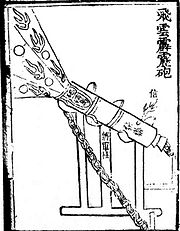
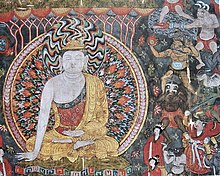
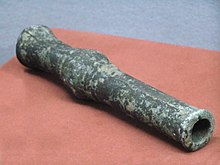






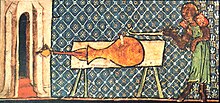






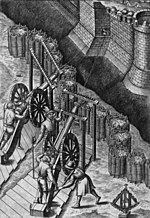


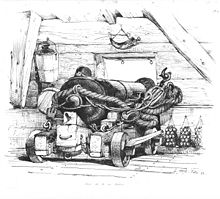
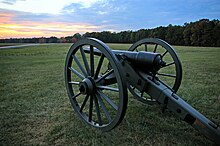




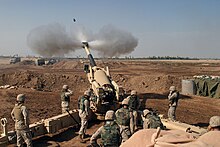












تعليقات
إرسال تعليق